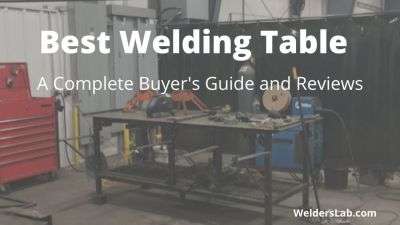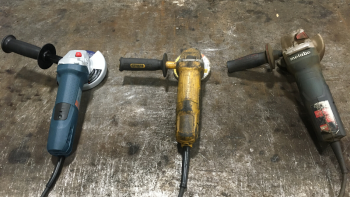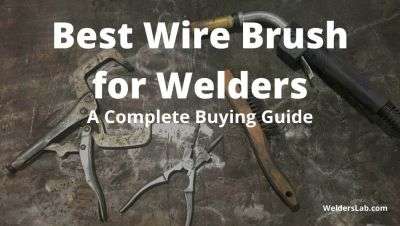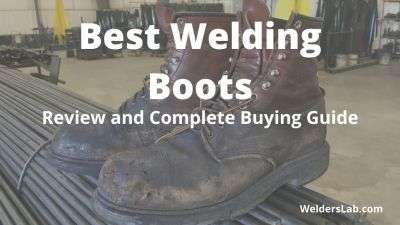3 Best Welders For Beginners – Complete Review (2025)
Thinking about buying your first welder? Not sure where to start? Finding the best welder as a beginner can feel overwhelming. Still, my goal in this article is to help simplify things and make a more informed decision regarding finding the best welders for beginners.
When it comes down, I’ve found the Hobart 500559 Handler, the Forney Easy Weld, and the Lincoln Electric 90i MIG and Flux Core Wire Feed Weld-PAK Welder to be the best options for their lightweight, ease of use, and ability to be used almost anywhere there is an outlet.
This article will cover what makes a good welder, the types of welders to consider, my top 3 picks, and as a bonus, I will share some extra tools you may want to consider.
3 Best Welders for Beginners
When it comes to finding the best welder for a beginner, the last thing I want to do is show you ten different welders and complicate the buying process even more.
Instead, I aim to share the three welders that may fit your situation as a beginner. So here they are…
#1 Hobart 500572 Handler 100
Hobart 500572 Handler 100
Our Take
The Hobart 500572 Handler 100 is a great little welder to start with. Works great for welding small projects up to 1/4″ metal. My one downside to this welder is that it is a fluxcore-only welder.
| Best For | Welding Small Projects |
| Price | Medium |
| Durability | Light Duty |
| Ease of Use | Great for Beginners |
Welder Type: Flux Core Wire
Cost: $$$
Features
- 5 Position Voltage Selector
- 700 Inch Per Minute Wire Feed
- Up to 140 Amperage Output
- Runs Off a 115v Standard Household Current
- Include an 8′ Lead and Ground Clamp
Pros
#1 Weld up to 3/16″ material. Typical welders at this size won’t do more than 1/8″ or 11 gauge material but this welder seems to handle it very well.
#2 Portable. At 44 pounds, this lightweight welder can be hauled around efficiently without too much space. So, this may be an option if you’re a farmer or just tinkering with stuff around your house.
#3 Can Weld Multiple Types of Material. This Hobart welder is made to run mild steel but can also do stainless steel and aluminum. However, you will need a shielding gas such as Argon or Stainless Tri-Mix to get a cleaner, more solid weld versus a flux core.
Cons
#1 Flimsy. One of the first things I noticed about this welder is that it feels flimsy. A few people have even mentioned that it had been dented on the side upon receiving the welder. This is the company’s fault but more the shipping company’s fault.
However, Amazon typically offers a 30-day return policy on items, so if this does happen, I will check and return the return policy.
#2 No Fine Adjustment on Heat Settings. While this welder is decent, it does not do all that great when doing all the fine adjustments. With this welder, you have five heat settings, but with more advanced welders, you’ll see more settings to dial things in and get a smoother weld.
However, if you plan to do something more advanced, this may not be your welder anyway.
#3 Lead is Short. Finally, the last thing to consider is the welding lead. The lead comes out of the welder and goes to the gun. The welder only has an 8-foot lead, which will work for most applications, but if you have to move around a bunch, this may not be long enough for you.
However, Hobart does make longer leads, but this will likely cost extra since this will require you to buy the lead and gun as one unit.
Who Should Buy This Welder
This may be a great welder if you travel around working on small projects. Also, if you love to tinker around at home, this welder will do most of the jobs you put in front of it.
#2 Lincoln Electric 90i MIG and Flux Core Wire Feed Weld-PAK Welder
Lincoln Electric 90i MIG and Flux Core Wire Feed Welder
Our Take
The Lincoln Electric 90i MIG and Flux Core Wire Feed Welder is a great option for beginners working on the road but also good for the hobbyist or DIY projects. Minus the higher price this is a great option.
| Best For | Travel Welding |
| Price | High |
| Durablility | Medium Duty |
| Ease of Use | Great for Beginners |
Welder Type: Wire and Flux Core
Cost: $$$$
Features
Comes with a 16-pound welder, weld gun, 10′ lead, 6′ gas cable & regulator, ground clamp, tips, and a nozzle.
Pros
- Lightweight – for a welder that only weighs 16 pounds, it works great for hauling around places.
- 115 volts – This welder also works great because it runs on any 120-volt outlet, which almost every place has.
- Wire – This welder also lets you run various types of wire for mild steel to flux core and even stainless and aluminum wire.
Cons
- Metal Thickness – One big downside to this welder is that you can only weld up to 1/8″ metal. Anything bigger than that, and you won’t penetrate as deep.
- The Helmet is Cheap – The other thing I don’t like about this welder is its cheapness. It doesn’t have a headband, and you have to hold it with your hand.
- Duty Cycle – One of the bigger downsides to this welder is that it only carries a 20% duty cycle at 30 to 120 amps. This means you can run this welder for 2 minutes straight, and then you have to let it cool down for 8 minutes so you don’t overheat it.
Who Should Buy This Welder
This welder makes a great fit for those looking to be more mobile and welding thin material such as thin gauge tubing or sheeting, say for someone doing some autobody work.
#3 Forney Easy Weld 261 140 FC-1 MIG Machine
Forney Easy Weld 261 140 FC-1 MIG Machine
Our Take
The Forney Easy Weld 261 140 FC-1 MIG Welder is a light easy to carry around welder that works great for small jobs, hobbyiest, and DIY projects around the farm or house. However this is a flux core only welder it still is a great option
| Best For | Small Projects |
| Price | Medium |
| Durability | Light Weight |
| Ease of Use | Easy to Use |
Welder Type: MIG Flux Core
Cost: $$$
Features
The Forney Easy Weld is a light-duty flux core MIG welder with an 8-foot lead, weld gun, and 8-foot ground clamp. It uses a 0.30 wire and runs on a normal 120-volt outlet.
Pros
- No Need For Gas – Since this is a Flux Core-only welder, you don’t need to worry about dragging a gas tank around.
- Light Weight – At only 19 pounds, it can be carried almost anywhere you need it.
- Better Duty Cycle – Of the three welders I’ve mentioned in this article, this welder is the only one with a 30% duty cycle at 90 amps, which means you can do 3 minutes of continuous welding and a cool-down period of 7 minutes.
- Metal Thickness – As small as this welder is, it will allow you to weld up to 1/4″ thick material.
Cons
- Runs Flux Core Only – The one big downside to this welder is that it is a flux core welder only. Flux core is typically more expensive, and if you want to weld other types of metal, such as stainless steel or aluminum, you’ll have to find a flux wire in those types of metals.
Who Should Buy This Welder
This welder is great for the beginner amateur who is just getting started and wants to do some tinkering around making some small projects.
It also may work well around a farm fixing up the odd and end things since flux core tends to work better outdoors. It should hold up as long as you’re not doing heavy-duty welding.
Click here to learn more about the Forney Easy Weld.
What Makes a Good Welder for a Beginner

As a beginner, you need to think about many things before you pick a welder. Every welder serves a different purpose, so here are a few things to think about.
#1 What type of metal do you plan to weld?
When it comes to welders, not every metal welds the same. Whether you’re welding mild steel, stainless steel, or aluminum you will need a machine that can handle those elements. Let’s dig into each option.
Mild Steel – In most cases, you’ll likely be welding mild steel. This type of steel is in most products around your house or farm. It will typically rust if left out in the open and have a black look or a carbon scale. You can weld mild steel with MIG, TIG, and Stick Welders.
Stainless Steel – Stainless steel is used in products you don’t want to rust. A good example of this is in my welding company, we do a lot of stainless steel troughs because animals drink out fo them and you don’t want them to rust. You can weld stainless with MIG, TIG, and Stick welders. However, with a MIG welder, you will need stainless wire and stainless trimix gas.
Aluminum – When it comes to aluminum, you’ll need a completely different type of welder that uses a push-pull gun. This is because aluminum is a very soft metal. You’ll also need straight argon gas using a MIG welder. Welding aluminum is probably one of the tougher metals to weld and is not recommended when starting.
#2 What is the thickness of the metal?
The second question is the thickness of the metal you plan to weld. If you’re welding 1/8″ mild steel, a lower amperage welder will work fine, but the thicker the metal, the higher the amperage you need.
As a result, this will also drive the cost up as well. However, if you’re looking for the best welder for a beginner, starting with a welder with a lower amperage may be better since higher amperage machines require 220v or 3-phase power.
#3 How easy is it to operate?
Finally, the last thing to consider is how easily the welder operates. Advanced welders can do all kinds of things, but when you’re first starting, there are only two main things you should worry about operating: your wire speed and the amperage output.
Wire Speed – Wire speed tells the welder how many inches per minute it should feed out while you are welding. Depending on the amperage output and thickness of the metal depending on how fast you set this. Typical beginner welders can run as low as 40 to as high as 700 inches per minute at no load.
Amperage Output – Amperage determines how hot the weld gets. Typically, the thinker the metal you are welding, the higher the amperage you’ll want. So if you’re welding something very thin, you’ll want to cut your amperage out back so you don’t melt through it. As a beginner, I wouldn’t go over a 200-amp welder.
3 Best Types of Welders for Beginners
Now that we’ve covered some of the basic questions you should ask yourself before you pick a welder, we need to look at the type of welder you should consider. There are three main types of welders MIG, TIG, and Stick Welders.
#1 MIG Welder
The first type of welder to consider, which I use the most, is a MIG welder. This is also one of the most common types of welding people will do.
MIG stands for Metal Inert Gas. It forms an arc between the wire and the metal workpiece, causing the wire and metal to melt and join. MIG also requires gas to shield the weld and protect it from contaminating the air. Typical gases used for welding are Argon and Helium.
You can also use a flux core if you don’t want to pay the extra cost of gas. Flux-core is a type of wire for MIG welders that comes coated, so you don’t need to use gas. This type of wire works well if you’re out in the open air because it won’t blow the gas away from your weld as quickly as your typical MIG welders.
To learn more about MIG welding, check out the short video below.
#2 Stick
Stick welders work the same way as wire, but you use a rod coated in flux instead of wire. Once the rod is struck against the metal, it arcs and melts the rod and workpiece, joining them together.
Once the weld cools, you must chip the slag away to see the final weld. This type of welder works great indoors and outdoors and can weld everything from mild steel, stainless steel, aluminum, nickel, and copper alloys. Of the three options, Stick can produce a lot of splatter and may take more work to clean.
To learn more about Stick Welding, check out the video below.
#3 TIG
TIG stands for Tungsten Inert Gas. TIG is the Cadillac of welding since it produces some of the cleanest welds. It uses a tungsten non-consumable rod inside the gun to create an arc. Tungsten is used because it melts at a very high temperature.
Like MIG welding, TIG uses a gas to shield the weld and protect it from outside contamination. TIG differs because tungsten does not melt and becomes a part of the workpiece. Rather, you will have to add this in by hand, or in some cases, you won’t need any filler rod.
Check out the short video below to learn more about how TIG works.
10 Extra Tools You’ll Need as a Beginner
Now that you have an idea of the kind of welder to buy as a beginner, I also want to share a few tools to consider that you may not have thought about.
#1 Welding Helmet
First off, to weld anything, you’ll need a welding helmet to protect your face and skin from getting burnt. Welding produces a very bright and powerful light. I’ve burnt my eyes several times from welding, equating it to someone throwing hot sand in your eyes.
A good welding helmet can be all it takes to prevent this from happening to you. The good thing is there are many different options today, from your standard helmets to the newer auto-dark helmets, which switch off and on as you use them.
#2 Welding Gloves & Jacket
Welding gloves protect your hands from getting burnt as well. Your hands will be the closest body part to the weld while it is running. The hotter you are running your welder, the more thinker the glove you’ll want.
Here are the welding gloves that I recommend and use.
You may also want to look at a welding jacket or shirt and gloves. Regarding welding closes, I’ve done everything from leather welding jackets to cotton button-down shirts. A good welding jacket will also prevent you from burning up your close.
If there is one thing I’ve learned over the years, it’s that it doesn’t take a lot of welding to burn yourself, and having the right protection will save you a lot of pain in the end.
#3 Welding Pliers
Every welder also needs welding pliers to help clean out the nozzle of your welding gun. Over time, the nozzle of your welding gun can build up with splatter, restricting the gas flow.
I’ve found this one to work great for me.
#4 Nozzle Gel
You’ll also want to use nozzle gel to help keep the nozzle on your welder nice and clean after you’ve removed all the splatter. I’ve used several different kinds, but almost any type will do.
Here is one I’ve used in the past that works great.
#5 Wire
When you buy your first welder, you may want to consider picking up some more wire since the welders I’ve mentioned above only carry 2-pound spools. They won’t last long if you’re doing a lot of welding.
Also, look to see if you can run a thicker wire. I prefer a 0.30 or higher.
#6 Wire Brush
Another tool every welder should have in their tool kit is a wire brush to clean off weld surfaces. Before you can weld, you’ll want to clean any dirty or rusty surfaces for better penetration.
If the surface is rusty it won’t complete the weld circuit and won’t arc until removing the rust.
#7 Chipping Hammer
I also like to use a chipping hammer with my MIG welder. Typically, they are used with stick welders to clean the slag off of your weld, but I like them to clean up the splatter around the weld.
#8 Cart
A welding cart is also nice, so you don’t always have to pick up your welder and move it around. It lets you hold your tools and shield gas in one compact cart for easier mobility.
It’s not a requirement, but if you are someone like me who has a lot of back pain, this can be a great way to avoid picking all the heavy stuff up.
#9 Safety Glasses
One thing every welder must have is safety glasses. I’ve had countless pieces of metal stuck in my eyes over the years, and it’s not fun trying to remove them.
Invest in a nice set of safety glasses and always wear them; your eyes will thank you.
#10 Hand Grinder
Finally, a hand grinder is a tool I like to keep in my arsenal. It’s not required because it can be expensive, but it works great for grinding down welds or cutting out old welds.











